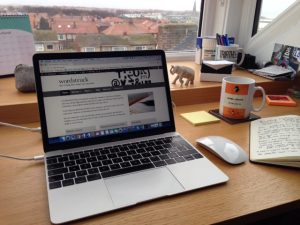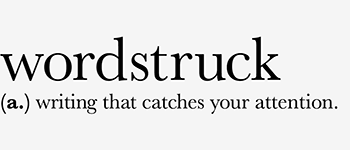There’s been a lot of chat about business blogging in my online networks this week, with several people expressing a lack of confidence about doing it.
I’m a writer. I blog and I have done for years. I’m not saying I always do it as well or as consistently as I could do, but I’m not afraid of writing blog posts for my own and other businesses. By addressing some of your worries and sharing what works for me, I’d like to help give you more confidence to blog for your business.
Why blog for your business?
There’s lots of advice about this, so I’ll give you the short version. Blogging is a relatively easy way to generate new content for your website. Search engines like new content, so your site appears higher in their rankings than static sites, and more customers find you.
Blogging is also a great way to establish your knowledge and expertise, to give your customers a chance to get to know more about you and your business and to build up a relationship with them.
I don’t like writing and I’m no good at it
 Who says you have to write a blog? Why not use video or photographs?
Who says you have to write a blog? Why not use video or photographs?
You don’t need fancy equipment and editing software for video or vlogs – a smartphone or the video mode on a digital camera will do. Film them selfie style, or fix your camera onto something. I’ve balanced mine on a pile of books before now.
Pictures also make great blog posts. A series of photos of an event, product or experience are an excellent way to show what your business does. You can add captions or let them tell their own story.
I am not great at using pictures in my blogs. I prefer to use my own to avoid rights issues. But I have found pixabay and Unsplash useful for sourcing rights free images and have created some of my own using Adobe Spark and Canva.
Or, best of all, hire a professional photographer to get some great pictures of you and your business that you can use time and time again. That’s on my to-do list in the next six months.
As for being confident or ‘good’ at writing blogs, all I can say is that if you don’t try, it won’t get any easier. Let your audience or customers decide how good you are. And if you need some help, then ask your friendly local writer for help with subjects, structure or writing style.
I don’t have any ideas for blog posts
This is quite difficult for me to understand, because I have ideas all the time. I watch the news, sign up for alerts to subjects I’m interested in, go for a walk, talk to people, look through photos on my phone. I read, I dream, I cook, I run – I mash things up from one area of my life and another. I have more ideas than I will ever get to write about.
Working in creative industries means I’ve always had to think of ideas. As a BBC Radio journalist I had to source at least two news stories a day, which meant generating a lot more than two ideas and working on them until I ‘found’ a story.
 As a creative copywriter, I had to generate lots of ideas for marketing campaigns. Here, working with other creative people really helped me to bounce ideas around, and spark new ones from others’ input. The trick was not to dismiss any idea straight away, to keep on generating them and only then start to apply filters about what would work well.
As a creative copywriter, I had to generate lots of ideas for marketing campaigns. Here, working with other creative people really helped me to bounce ideas around, and spark new ones from others’ input. The trick was not to dismiss any idea straight away, to keep on generating them and only then start to apply filters about what would work well.
I take the same approach to blogging now. If I’m asked to write about a particular theme or subject, I’ll do a bit of research and then jot down as many ideas as I can. I’ll leave them for a while before coming back to them to decide which ones to present to a client.
I write ideas down in OneNote, and in my notebooks. Nowadays, I normally have a phone or notebook with me, but I have scribbled things on the back of bus tickets in my time. Most of my ideas are a sentence, phrase or question that acts as a prompt, but sometimes they can be a quote or an observation.
I don’t think my ideas are any good
If you want to be strategic and smart about blogging for your business, then think about your audience or your customers and what they would be interested in. Here are a few themes to get you started:
- What advice can you pass on?
- Share your view of what goes on ‘behind the scenes’ – what goes into your product or service?
- Review an activity, event, place, product or service
- What do you wish you’d known when you started in business?
- Think about questions that your customers always ask you – can you answer some of these in a blog post?
- How can you help your customers do business with you or a closely related business? For example this guest post for Whiteacres Design offers great tips for choosing a commercial photographer
If those aren’t enough then here are 50 ideas for your business blog.
And if you’re still struggling, then drop me a note in the comments below or contact me through the Wordstruck facebook page.
I don’t have time to blog
As a business writer, one of the services I offer is to write blogs for your business. So, it may seem a bit odd that I’m writing this blog post, as I could be doing myself out of business. But I recognise that not everyone has the budget or inclination to hire a writer. And I love writing so much that I want to share that with you.
Here are some of the things that helped me:
Set a time and place for blogging
 My brilliant writing mentor John Simmons has written a weekly blog post for years. He sets aside a specific day and time to write.
My brilliant writing mentor John Simmons has written a weekly blog post for years. He sets aside a specific day and time to write.
I wrote a weekly blog on a writing theme for over a year, following the same discipline and setting aside an hour a week to do it.
I didn’t always complete my blog post in that hour, but I made a start. Sometimes I could extend that time, sometimes I had to find it somewhere else. But I made it a goal to get it written and published.
Make yourself accountable
I set myself a weekly blogging goal because I wanted to generate content, and because I wanted to test my ability to come up with new ideas on a consistent basis. This was actually the start of convincing myself that I had the right attitude to set up in business for myself.
If it helps, tell someone what your business blogging goal is, or at least write it down e.g. I will post a blog about my business once a week for 6 weeks. I announced mine on my twitter profile.
Take on a bet, or promise yourself a reward for sticking to your blogging goals. Buddy up with your social or business network and challenge and support each other.
Just do it
Blogging is a great way to develop your confidence in writing and talking about your business. Remember, you’re in charge of what you publish and when. And, you can go back and edit things (even delete them) if you want to.
So, try not to get too hung up on writing the perfect blog post . Just write it and publish it. After you’ve taken a deep breath and calmed down, go back and look at the responses, comments, views and analytics and use them to help you decide what to post next.
Special business blogging offer
Writing this blog post has made me realise there’s a lot more I could say about business blogging. So I’d like to hear from you. What challenges and concerns do you have about blogging for your business? What more would you like to know?
Please add your comments below or get in touch with me via the Wordstruck facebook page. I promise to respond to every comment.



 Who says you have to write a blog? Why not use video or photographs?
Who says you have to write a blog? Why not use video or photographs? As a creative copywriter, I had to generate lots of ideas for marketing campaigns. Here, working with other creative people really helped me to bounce ideas around, and spark new ones from others’ input. The trick was not to dismiss any idea straight away, to keep on generating them and only then start to apply filters about what would work well.
As a creative copywriter, I had to generate lots of ideas for marketing campaigns. Here, working with other creative people really helped me to bounce ideas around, and spark new ones from others’ input. The trick was not to dismiss any idea straight away, to keep on generating them and only then start to apply filters about what would work well. My brilliant writing mentor
My brilliant writing mentor